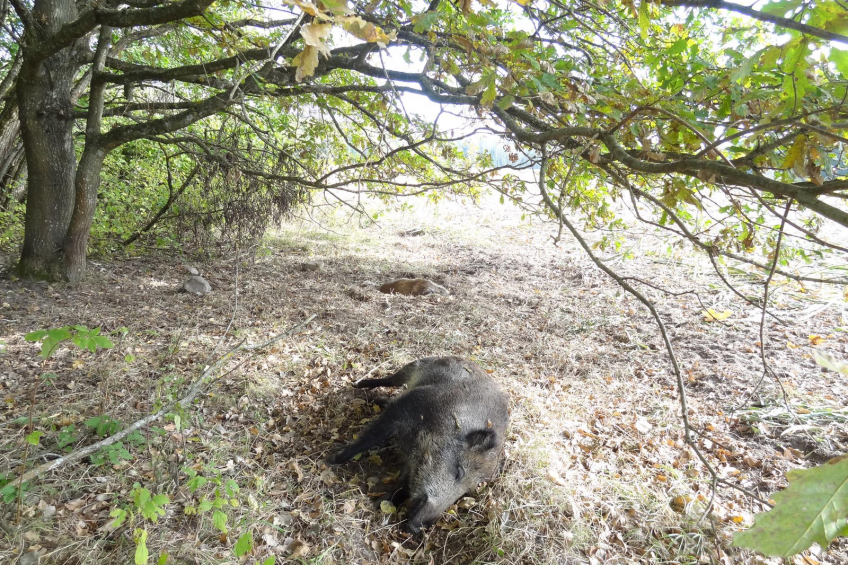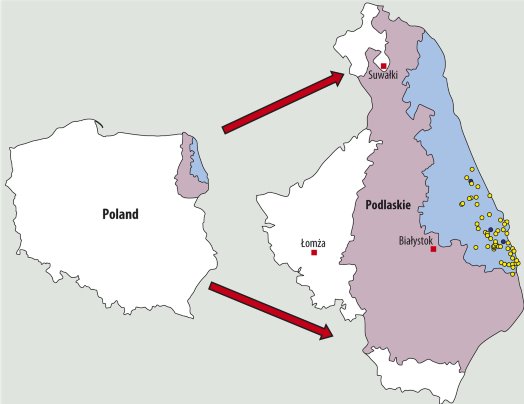How Poland controls African Swine Fever

The Polish know it as Afrykanski Pomór Swin – African Swine Fever. For about one and a half years, the disease has occurred in the North East of the country, mostly in wild boars and close to the border with Belarus. How did Poland cope?
For the first time in history African Swine Fever (ASF) was diagnosed in Poland on Friday evening, 14 February 2014. The DNA of the ASF virus (ASFV) was detected with a programme from the Chief Veterinary Officer (CVO), which aims to detect ASFV early and broaden the knowledge on the risks associated with the emergence of ASF in Poland. A sample of bone marrow was isolated from a front leg of a male wild boar that weighed about 50 kg.
The boar was found dead and completely frozen in a stream on 3 February. It was found by a farmer, near the village of Grzybowszczyzna (in Szudzialowo community, Sokolka county, Podlaskie voivodeship), about 900 m from the border with Belarus. The farmer, who kept six pigs of different ages, reported it to the county’s veterinary inspector.
The biosecurity level at that farm was low, typical for small backyard holdings. Due to the heavy winter, the veterinary inspector collected the sample on 13 February and submitted it for ASF examination, to the National Reference Laboratory (NRL), located at the National Veterinary Research Institute in Pulawy, Poland.
Although the epidemiological situation regarding ASF had been unfavourable as from 2007, there were suspicions of ASF in Russia and Belarus since 2011. Near the north eastern Polish border, the detection of the first case of ASF was challenging for veterinary inspection, laboratory, farmers, hunters and the government.

Map of Poland, with Podlaskie province in Eastern Poland highlighted. The dark blue dots refer to outbreaks in domestic pigs; the yellow dots to outbreaks in wild boars. The light blue zone is the infected area hence a restriction zone; the purple area is a protection zone.
Second result
Three days later, on Monday, 17 February, the NRL obtained a second positive result for ASFV in the blood clots, spleen, kidney, and lung, collected from female wild boars, weighing about 100 kg, found dead in the forest area between the villages of Kruszyniany and Ozierany Wielkie, in the Sokolka county, about 2 km from the border with Belarus.
Following these first two cases of ASF, the epidemiological investigations related to the occurrence of ASF in Poland were initiated immediately. In order to evaluate the epidemiological impact and potential spread of ASFV in the above-mentioned areas, all the pigs belonging to the farmer, who informed about the first dead wild boars and all other pig farms located within a radius of 10 km from the ASF cases, were examined using molecular and serological tests. In total blood samples were collected from 623 pigs from 118 farms in 57 locations. All of the samples were negative in both tests.
A buffer zone was also established. Initially it was 145 km long and 40-70 km wide, the surface of the zone was around 700 km2. The number of herds in the zone was 10,665, including seven big herds, and the number of pigs was 397,028. The density of pig population in this region was low (<800 pigs km>2). Thereafter new zones had been established in accordance with the European Commission Decisions.
Increased search
At the same time, an increased search for dead wild boars was initiated within a radius of about 40 km from the cases. Within 97 days, despite an intensive investigation, no increase was found with regard to mortality of wild boars or in the morbidity/mortality of domestic pigs kept at farms located within a 40 km radius from the ASF cases and along the border with Belarus and Lithuania. In addition, no more positive animals in laboratory examinations were evidenced. This suggests that within this period ASFV was not transmitted to other animals. Unfortunately thereafter, from the end of May until the end of December 2014, 27 new cases of the disease were registered.
Domestic pigs
The first outbreak of ASF in domestic pigs was declared on 22 July 2014, in a backyard holding of eight pigs, located 2.5 km from the border with Belarus. It was, however, determined that on 17 July three pigs had died and had been buried by the owner. As two more pigs became sick on 19 July, the owner informed the county veterinary inspection who took samples from two dead and three sick pigs. Laboratory tests gave positive results for ASFV and thereafter the three pigs remaining were immediately culled and carcasses were destroyed under official supervision.
The second outbreak in domestic pigs was identified on 16 August 2014, in a low biosecurity holding with only one pig, located near the forest, 3 km from the border and approximately 13 km north from the location of the first outbreak. In both outbreaks control measures, including stamping out, carcass disposal, cleaning, disinfection and destruction of feedstuffs, bedding and manure, establishment of protection and surveillance zones were implemented immediately, according to the law. Altogether, 346 pigs from 92 holdings were killed. Summing up, in 2014, Poland notified 30 cases of ASF in wild boars – these involved 57 wild boars of different ages and sex, 48 found dead in the forest or field, alone or in small groups of maximum six individuals, and nine hunted wild boars.
In addition, two outbreaks in backyard holdings were reported, affecting six pigs in total. All the findings occurred in the north east of Poland, in five communities (Szudzialowo, Krynki, Grodek, Michalowo and Sokolka) of two counties (Bialystok and Sokolka) in one voivodeship (Podlaskie). All were found within 19 km of the border with Belarus. All these data indicate a rather slow spread of ASF in Poland. When tested, 12.3% of the wild boars positive in PCR were also serologically positive.
No recovered animals have been reported, however. This suggests that so far ASFV cannot persist in isolated wild boars for a long period without the interaction of other factors. The highest number of infected wild boars were registered in July 2014. The mean monthly distance of wild boar movement was 3 km (0-16 km) and the longest distance of wild boar movement was 30 km. The correlation between the density of wild boars and the number of infected animals was evident.
Molecular examination
Based on the molecular examination it was established that Polish ASFV isolates belong to genotype II. The sequence analysis of the intergenic region (between the I73R and I329L genes) demonstrated the insertion of an additional tandem repeat sequences (TRS) at the nucleotide position number 136. Polish ASFV isolates were grouped in the same clade as Belarusian virus from DP from 2013, as well as in Lithuanian isolate from 2014. TRS was absent in earlier Russian and Georgian viruses. This finding suggests that the origin of ASFV in Poland, especially in relation to the fact that the situation in Belarus, is not entirely clear.
Although there are no official data on the prevalence of ASF in the Belarusian wild boar population, the fact that wild boars were intensively shot throughout the country in 2013/2014, may suggest that the official data do not reflect reality. In 2015, up to 24 April, 25 cases (involving 44 dead and one hunted wild boars and one outbreak (involving five pigs) were declared to the World Organization for Animal Health (OIE). Again, all of them were located in Podlaskie voivodeship.
First detection
In summary, from the first detection of ASF in Poland up to now, 55 cases (43 cases in dead and 12 cases in hunted animals; involved in total 102 wild boars) and three outbreaks (involved 11 domestic pigs), located in seven communities of three counties in Podlaskie voivodeship, were evidenced. Due to the unfavourable epidemiological situation in the region the strong collaboration between infected EU countries was initiated in June 2014. It should be mentioned that, due to the unfavourable situation near the eastern border of the country, as early as in 2011 the CVO decided to monitor the epidemiological situation with regard to the occurrence of ASF.
In 2011 and 2012 laboratory examinations were performed on a small scale, with special emphasis on the 40 km zone along the eastern border, but as from 2013 the programme was implemented through the country. It was modified in 2014 and 2015, according to the current needs. As part of the programme, an active surveillance of domestic pigs and wild boars was performed.
The samples of blood and tissues were collected from all sick or dead pigs with symptoms suggestive of infectious disease, from all wild boars found dead, including those from traffic accidents, and from all hunted wild boars from restricted areas, as well as from 5-10% of hunted wild boars from the rest of the country. All the samples were collected by the counties’ veterinary inspectors and all were examined at the NRL. In total, from 2011 up to now, 65,067 animals were examined.
Public awareness
Additionally, an intensive public awareness campaign was conducted. It comprises of information:
- published on the web pages of CVO and NRL;
- published in popularised scientific, farmer’s and hunter’s journals;
- distributed in leaflets (394,000 distributed in 2013);
- shared at meetings and lectures for county veterinary inspectors, practitioner vets, pig breeders and producers, traders, pork processors, hunters and forest rangers.
It might be concluded that the campaign was successful because most of the wild boars found dead were announced by people, including the first case of ASF. Within the frame of the control programme, food of animal origin was confiscated and utilised by veterinary border inspection.
Biosecurity
It should also be stressed that Polish farms, also in the affected region, have a different level of biosecurity. Swill feeding, however, is prohibited and controlled by the veterinary inspection. There are no free-ranging pigs and outdoor keeping of pigs happens occasionally, currently it is prohibited in the affected region. Nowadays a new, very strict programme of biosecurity for the affected region, is implemented. Moreover, an electronic swine identification and registration system is used, all pig farms are registered in a database, and illegal markets do not exist in Poland. These factors facilitate the control of pig/pork trade. In the case of an outbreak of ASF, compensation funds are available for farmers.
Impact
The occurrence of ASF had a negative impact on pig production in Poland, mainly due to the ban on export of Polish products to Russia, it also affected the prices of pork locally, especially in the restricted region. Nowadays, due to the availability of food and lower hunting activity in restricted areas in the spring of 2014, the challenge for Poland is an increase of the wild boar population. Therefore the main goal for the country will be to keep the wild boar population at a steady level. There should be an improvement of biosecurity in backyard farms, to ensure no circulation of the virus between domestic pigs and wild boars. Due to the interaction of several factors, the situation concerning ASF is nowadays complex and dynamic.
Therefore, the likelihood that ASFV will spread to nearby unaffected areas is moderate, when factors such as – the continuous forest corridors, the ecology and behaviour of wild boars, habitat structure and its shearing, high mobility and sociality of wild boars, the contamination of the environment and long persistence of ASFV in a contaminated environment – will be taken into account. When human-associated factors are considered, the risk of ASF dissemination is higher.
Article featured in Pig Progress 31.4











